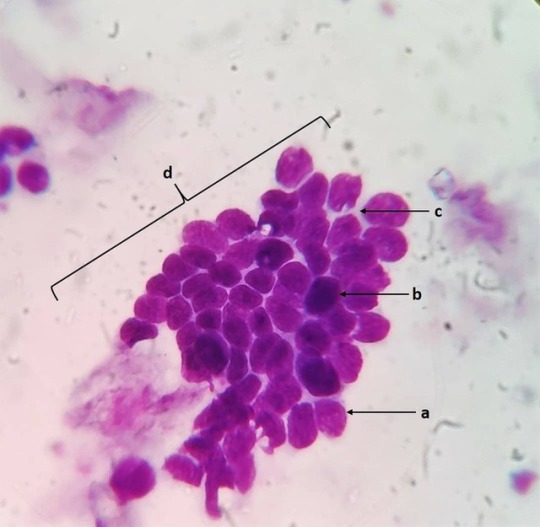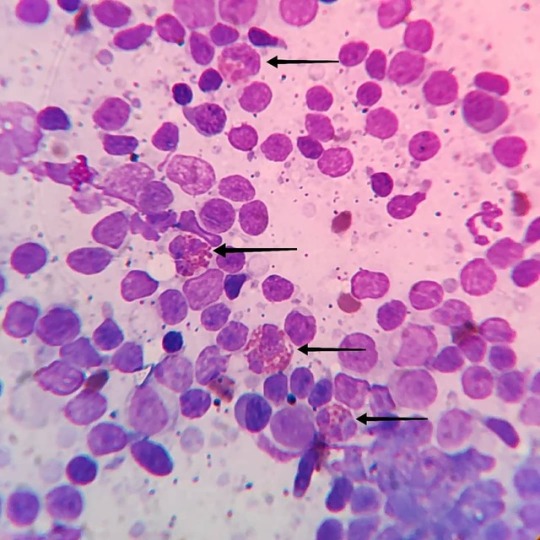#vetclinpath
Photo

Basal cells: Location: Basal layer of all epithelia. Characteristics and function: Stem cell regenerative compartment for epithelial structures. Shape and size: Small round cells with a high N:C ratio. Nucleus: Round (a) to ovoid (b) centrally placed with compact chromatin. Cytoplasm: Scant with mild basophilia (c). Cytoarchitecture: Pavement (d) or columnar. Ddx: Matured lymphocytes. #vetpath #vetpathology #vetpathologist #vetcytology #vetcyto #veterinaryclinicalpathology #vetclinpath #veterinarycytology #veterinarycytopathology #veterinarymedicine #vetlabdiagnostic #vetcases #vetlife #normalcaninecell #basalcell #vetlablife #veterinary_medicine #vetmed https://www.instagram.com/drdashvetpath/p/BweUHo2Bi7J/?utm_source=ig_tumblr_share&igshid=1hu6g0s917um0
#vetpath#vetpathology#vetpathologist#vetcytology#vetcyto#veterinaryclinicalpathology#vetclinpath#veterinarycytology#veterinarycytopathology#veterinarymedicine#vetlabdiagnostic#vetcases#vetlife#normalcaninecell#basalcell#vetlablife#veterinary_medicine#vetmed
0 notes
Photo

Fleas Ctenocephalides Felis: Most commonly seen fleas in household cats and dogs. Principle host of the cats but also seen infesting dogs and other mammals. Fleas go through 4 life cycle phases egg, larva, pupa and adult. It's is estimated that a female lays somewhere between 5000 to 8000 eggs during her life. The fleas need to feed on a blood meal before they start producing eggs. The eggs develop to larvae in around three to six weeks. The larvae are negatively phototrophic and hide from the light unto the ground substrates. They again moult to pupae by spinning a Coccon and waiting for suitable environmental conditions and for a suitable host. The adult fleas are capable of detecting the CO2 and temperature from the hosts and this helps in lodging of the fleas to the hosts body. Clinical signs and symptoms develop due to allergic reactions towards the substances present in the fleas saliva (Flea allergy dermatitis - FAD). Morphological differentiation between C. felis and C. canis: a. The first spine of genal comb of C. felis is almost the same length as the second, in C. canis is almost half the length. b. Head of C. felis is more rounder and longer than that of C. canis. c. C. felis - tibiae of all 6 legs have 7 to 8 bristles C. canis - tibiae of all 6 legs have 4 to 5 bristles. To effectively control fleas, both the fleas on the animalss as well as the fleas and eggs in the surroundings have to treated. Adulticides along with insect development inhibitors (Lufeneuron) and insect growth regulators (Methoprene) have been used effectively to control flea population. Spot on (Imidacloprid, fipronil, Methoprene) solutions are more effective alternative in pets rather than the commercial available sprays and dips. #vetpath #vetpathology #vetclinpath #vetclinicalpathology #vetlabdiagnostic #veterinarypath #veterinaryclinicalpathology #veterinarypathology #veterinaryparapathologist #vetdermatology #veterinarydermatology #veterinaryentomology #vetlaboratory #vetdiagnostics #vetparasitology #veterinaryparasitology #vetparasite #flea #catflea #dogflea #ctenocephalidesfelis #externalparasites #fleaallergy #fleaallergydermatitis #wetmount #parasites https://www.instagram.com/drdashvetpath/p/BvyuuHyhN9f/?utm_source=ig_tumblr_share&igshid=mnofp94i184l
#vetpath#vetpathology#vetclinpath#vetclinicalpathology#vetlabdiagnostic#veterinarypath#veterinaryclinicalpathology#veterinarypathology#veterinaryparapathologist#vetdermatology#veterinarydermatology#veterinaryentomology#vetlaboratory#vetdiagnostics#vetparasitology#veterinaryparasitology#vetparasite#flea#catflea#dogflea#ctenocephalidesfelis#externalparasites#fleaallergy#fleaallergydermatitis#wetmount#parasites
0 notes
Photo

Trypanosoma spp. in canine blood smear: Seen are trypomastigote stages trypanosoma parasites in the blood smear of a dog. They are extracellular parasites seen feeding on blood and also on lymph. Trypanosoma spp. are flagellate parasites bearing a undulating membrane observed in the blood of mammals. The parasites also posses a kinetoplast, a small disc like structure containing mitochondrial DNA seen close to the nucleus. T. evansi and T. cruzi are seen most commonly infecting the domestic dog. Other species like T. congolensis, T. vivax, T. equiperdum, T. brucei and T. rangeli are also seen infecting dogs, humans and other mammals. Dogs serve as reservoir hosts and helps in spreading the infection to humans. The common vectors involved in the transmission of Trypasnoma spp. parasites are the Tse-tse flies and kissing bugs (Triatoma spp.). #vetpath #veterinarypathology #veterinaryclinpath #vetclinpath #veterinaryhaematology #haematology #clinicalhaematology #veterinaryparasitology #veterinaryparapathologist #veterinaryparasites #vetparasite #bloodsmears #parasitology #wetmount #bloodparasite #flagellates #parasitism #parasiticinfection #trypanosoma #trypanosomiasis #caninetrypanosoma #trypanosomes #trypanosome #kissingbugs #tsetsefly #triatoma https://www.instagram.com/drdashvetpath/p/BvlncHxBPfM/?utm_source=ig_tumblr_share&igshid=16yzwb5d6esr3
#vetpath#veterinarypathology#veterinaryclinpath#vetclinpath#veterinaryhaematology#haematology#clinicalhaematology#veterinaryparasitology#veterinaryparapathologist#veterinaryparasites#vetparasite#bloodsmears#parasitology#wetmount#bloodparasite#flagellates#parasitism#parasiticinfection#trypanosoma#trypanosomiasis#caninetrypanosoma#trypanosomes#trypanosome#kissingbugs#tsetsefly#triatoma
0 notes
Photo

Eosinophilic lymphadenitis: Eosinophils are not commonly observed in the lymph nodes. Individually or seen in aggregates in cases like chronic skin infections, allergic and hypersensitivity reactions, paraneoplastic response, fungal and parasitic infections. Prognosis is good but also depends on the underlying cause (Inflammatory or paraneoplastic response). #vetpath #vetpathology #vetclinpath #veterinarypathology #veterinaryclinicalpathology #fineneedleaspirationcytology #fineneedleaspirate #fineneedleaspiration #cytology #cytologyvet #veterinarycytology #lymphnode #lymphadenitis #eosinophils #caninecytology #dogcytology #cytopathology #cytopath #veterinarycytopathology https://www.instagram.com/drdashvetpath/p/BvTETR4hc3A/?utm_source=ig_tumblr_share&igshid=k1qkf226vr57
#vetpath#vetpathology#vetclinpath#veterinarypathology#veterinaryclinicalpathology#fineneedleaspirationcytology#fineneedleaspirate#fineneedleaspiration#cytology#cytologyvet#veterinarycytology#lymphnode#lymphadenitis#eosinophils#caninecytology#dogcytology#cytopathology#cytopath#veterinarycytopathology
0 notes
Photo

Epidermal cyst with pyogranulomatous inflammation in a dog: As seen in the images many polymorphonuclear cells are seen surrounding the irregular dark basophilic material. Multinucleated foreign body giant cells along with variable number of macrophages can also be observed in aspirates. The dark basophilic material seen are aggregates of keratinized materials which have been ruptured from the cyst into the surrounding tissue. A inflammatory response is set by the host to clear out the debris along with keratinized materials out of the involved tissue. #vetpath #vetpathology #veterinarypathology #veterinarypath #vetclinpath #veterinaryclinpath #veterinaryclinicalpathology #vetclinicalpathology #cytology #vetcytology #veterinarycytology #aspirate #aspirationcytology #aspirate #vetlabdiagnostic #veterinarylabdiagnosis #cytologicalexamination #cytologylab #cytologyvet #fnac #fna #caninetissue #epidermalcyst #dermatology #vetdermatology #veterinarydermatology https://www.instagram.com/drdashvetpath/p/BvGNW39h3R-/?utm_source=ig_tumblr_share&igshid=16c5bpw8m5clt
#vetpath#vetpathology#veterinarypathology#veterinarypath#vetclinpath#veterinaryclinpath#veterinaryclinicalpathology#vetclinicalpathology#cytology#vetcytology#veterinarycytology#aspirate#aspirationcytology#vetlabdiagnostic#veterinarylabdiagnosis#cytologicalexamination#cytologylab#cytologyvet#fnac#fna#caninetissue#epidermalcyst#dermatology#vetdermatology#veterinarydermatology
0 notes